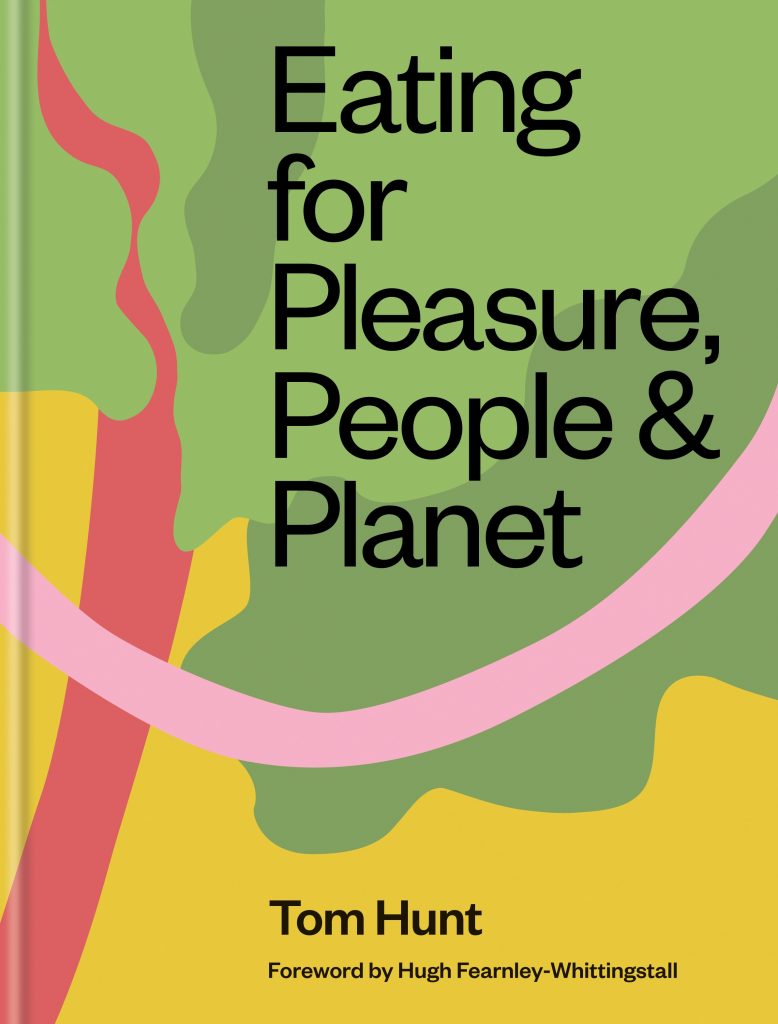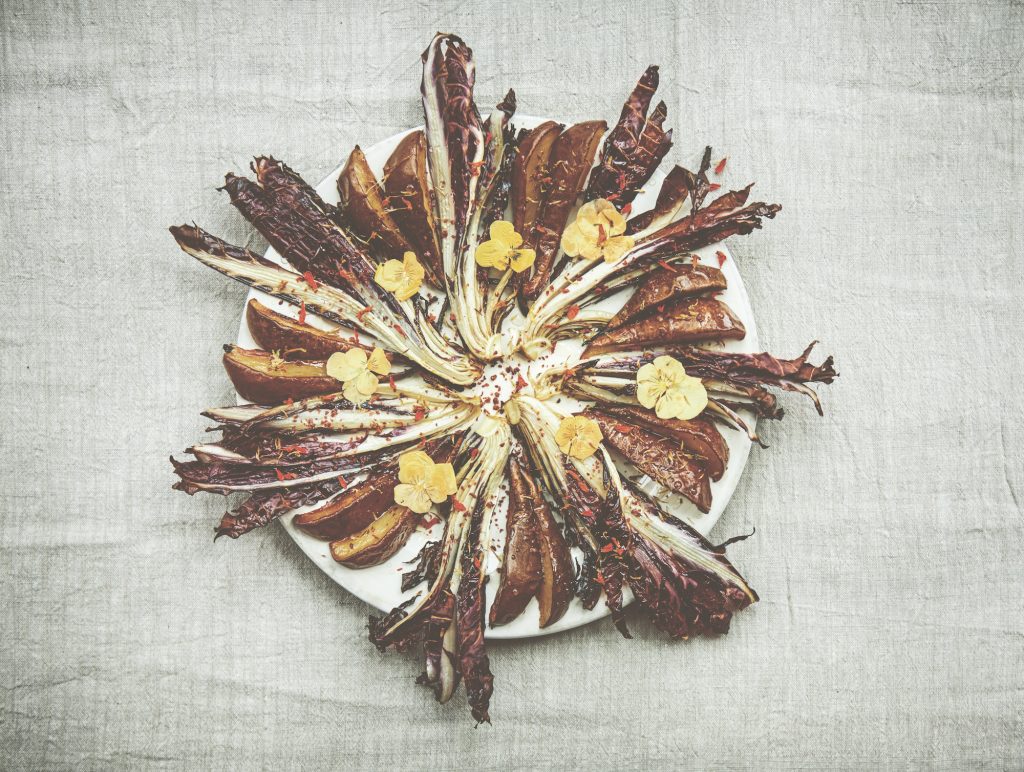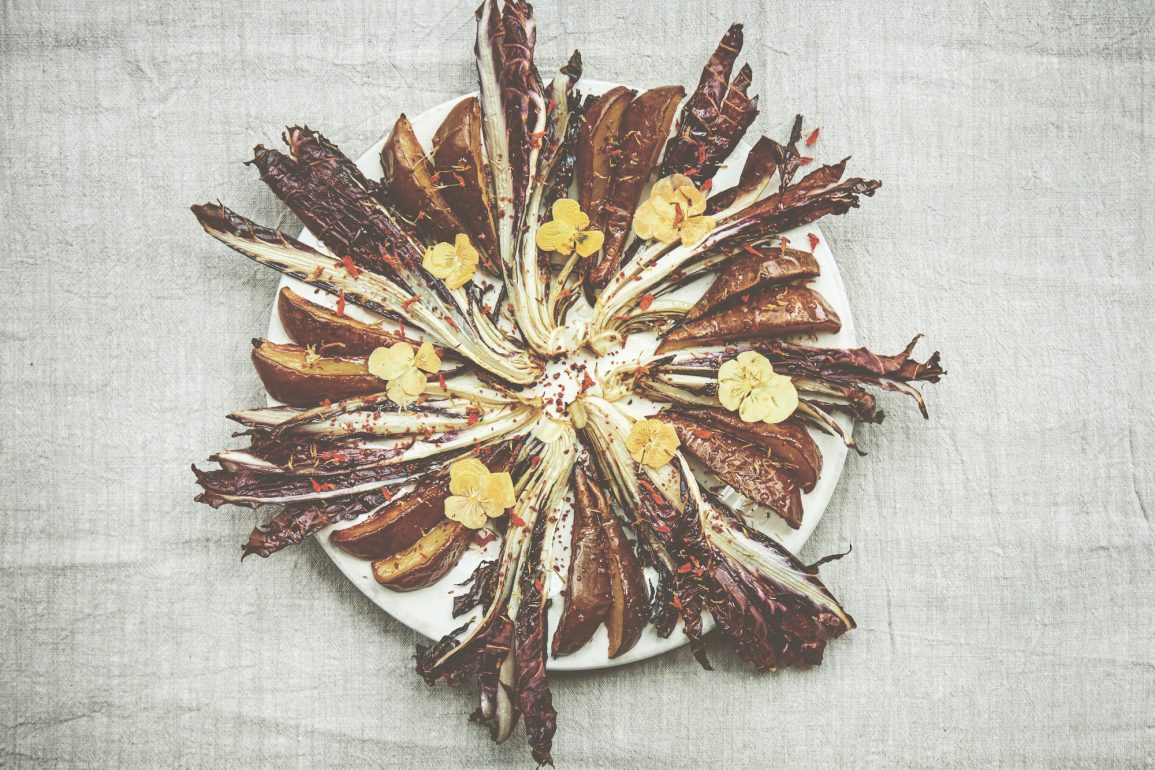Eating for Pleasure, People & Planet – It’s National Vegetarian Week folks – designed to highlight to the public the benefits of a meat-free diet. Well, I don’t know about you, but I like to eat meat, but we are increasingly eating less, and better quality. Also, I’m encouraged to experiment more with vegetarian dishes, as more and more fabulous cookbooks come to my attention. One of these is newly published Eating for Pleasure, People & Planet by Tom Hunt. Tom’s Bristol Restaurant Poco has won numerous awards, including Best Ethical Restaurant at the OFM Awards. He writes for many newspapers offering ingenious no-waste recipes.

Tom is on a mission to have us all sourcing, cooking and eating in a way that helps fight food waste and prevent further climate change. For example, those tough kale stalks that I tend to chuck into the recycling; Tom suggests using them to make a risotto, or steam them, or even fry them. Cauliflower too… he suggests using the whole thing (Crystal Poodle won’t like that as she loves raw cauliflower stalk!). But more than that, Tom’s new book demonstrates how we can all adapt our ways and become part of the solution. It shows us how we can have a more sustainable diet and cut down on waste.
The recipes are vibrant and celebratory, yet simple, nourishing and affordable. They are all born out of his extensive research and in line with the most up-to-date food sourcing guidelines. The chapters include Morning Meals, Slow Food Fast: Lunch and Supper, A New Way With Salads, Family Meals and Feast Plates, Sweet Treats and the Larder. It really is a magnificent tome – a great gift and an inspiration for anyone who is a keen vegetable grower and/or consumer.
I’ve chosen a few recipes from the book that I felt ideal for this time of year. Root Vegetable & Linseed Latkes make a lovely weekend brunch dish, and the Purple Sprouting Broccoli with Orecchiette is perfect for a midweek supper dish, especially while these delicious stems are in season.

Root Vegetable and Linseed Latkes
A ‘latke’ is a traditional Jewish potato cake that also works very well made with other root vegetables. In this recipe, I replace eggs with nutty, omega-3-rich linseeds, which help bind the mixture together. Play around by adding different flours to see how the taste affects the flavour of the latke: you’ll find spelt has a nutty flavour, while rye is malty and wheat more subtle and rounded. Latkes make a hearty breakfast served with apple compote and yogurt. Alternatively, they’re delicious served as part of an evening meal.
Serves 2
150g mixed root vegetables, grated (e.g. beetroot, celeriac, turnip, etc.)
half an onion, grated
1 tbsp wholegrain flour
1 tbsp wholegrain mustard
2 tbsp ground linseeds
1 tsp baking powder
glug of extra virgin olive oil, for frying
To serve, optional
carrot or parsley leaves, apple compote, yogurt
Combine the grated root vegetables and onion in a bowl with a good couple of pinches of sea salt and set aside for 5 minutes to draw out some of the excess moisture from the vegetables. Pick up handfuls of the mixture and squeeze out all of the juice, placing the squeezed vegetables in a clean bowl. Keep hold of the excess liquid, which makes an incredible salad dressing mixed with a little extra virgin olive oil. Add the flour, mustard, linseed and baking powder to the grated vegetables and mix well to combine.
Heat the olive oil in a frying pan over a medium heat. Divide the vegetable mixture into four balls and place them in the pan. Flatten the latkes slightly with a spatula and leave them well alone for 3-5 minutes, or until they are golden on the underside and ready to flip. Carefully turn them over and cook for a few more minutes or until golden brown. Serve immediately, with the leaves, compote and yogurt, or save and reheat in the oven.

Purple Sprouting Broccoli with Orecchiette
I make this dish when I fancy a simple, flavoursome and homely lunch or supper.
The caper sauce is so umami-rich, it removes the need for any cheese or anchovies in the dish, keeping it affordable and low impact. It takes very little preparation to make if you have the pasta to hand. However, if you want to avoid the plastic packaging that pasta is usually wrapped in, you’ll have to try making it yourself from scratch. Although it is an involved process, it’s very simple and fun to make and a good opportunity to add other interesting wholemeal flours to the dough.
Serves 2
200g purple sprouting broccoli, or other greens
glug of extra virgin olive oil
1 heaped tbsp salted capers, soaked in water for 10 minutes, then drained, or brined
1 small garlic clove, roughly chopped
200g wholemeal pasta, orecchiette or similar
half an unwaxed lemon, zest and juice
dried chilli flakes, to taste
Place a large pan of salted water on to boil.
Thinly slice the thicker stalks of the purple sprouting broccoli or other greens, leaving the tender stalks and leaves whole.
Warm a good glug of extra virgin olive oil in a large pan over a medium-low heat. Fry the capers until they start to crisp, then add the garlic and cook for just a minute without colouring. Set aside.
If using dried pasta, boil it in the salted water for 6 minutes, then add the greens, bring back to the boil and cook for a further 3 minutes. If using fresh pasta, boil the greens first for 1 minute, then add the fresh pasta and boil for a further 3 minutes. Strain the pasta and greens into a colander, then immediately transfer them to the pan with the garlic and capers.
Season with the lemon zest and juice, some freshly ground black pepper and salt, if necessary, bearing in mind the capers are salty anyway. Serve in pasta bowls, sprinkled with the chilli flakes and liberally with breadcrumbs.

Roasted Pear And Radicchio with Dried Summer Flowers
Serves 4 as a side dish or starter
This was one of my favourite recipes to make at our Bristol restaurant Poco, when we opened the doors back in 2011. After doing a short internship at Rene Redzepi’s restaurant Noma in Copenhagen, I tweaked the original to include edible flowers. Redzepi’s team used them in abundance decorating many of the plant-based dishes we made whilst I was there.
In autumn, edible flowers become more scarce, but until the first frosts, bright orange and yellow nasturtiums do well. After the frost, hardy yet beautiful pansies march on. If you want to use edible flowers during the winter, you might have to wait for primroses to pop up, or with foresight, you can dry and preserve summer flowers very easily. Just remove their stalks and lay them in the sun or a warm space until they dry completely, or press them inside books, before storing in a dry container.
This dish has a lovely autumnal feel. Roasting the pears brings out their bronze tones and almost makes them shimmer like gold. Complemented by the edible flowers, this dish is perfect for a feasting table.
2 firm conference pears
1 small radicchio
glug of extra virgin olive oil
3 oregano sprigs, flowers and leaves picked
1 tsp Aleppo pepper or chilli flakes, optional
edible flowers, optional
maple syrup, or another sweetener, to serve
Preheat the oven to 180.C/350.F/Gas Mark 4.
Cut each pear into six wedges and remove the inedible core. Slice the radicchio into eight wedges.
Place the pear and radicchio on a baking tray, drizzle with the olive oil and season with salt and pepper. Roast in the oven for 35 minutes or until just soft and slightly browned.
Serve on a platter, dressed with the oregano, Aleppo pepper or chilli flakes and edible flowers, if using, and a drizzle of sweetener.
Eating for Pleasure, People & Planet by Tom Hunt is published by Kyle Books, £26 hardback (octopusbooks.co.uk) Photography: Jenny Zarins
The Seasoned Gastronome
Twickenham & Richmond Tribune


